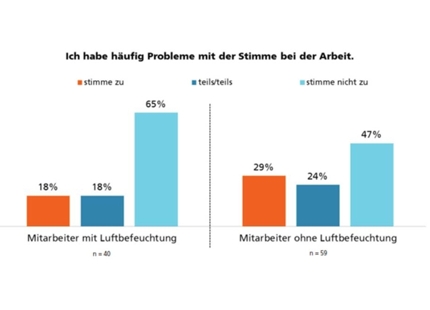
Fraunhofer Study on air humidity

The healthy office
Fraunhofer Study on air humidity
The Fraunhofer Institute for Industrial Engineering IAO examined the importance and effect of air humidity in the office in a 2-year study. The results show that air humidity has a positive effect on workplace assessment and has also shown to be beneficial to the health and productivity of the office associates.
The tests were done in the centre for virtual engineering ZVE at the Fraunhofer IAO in Stuttgart (picture above) and were further supported with a web-based survey in collaboration with the course study: Facility Management by HTW Berlin.
Three direct room humidification units from the DRAABE NanoFog Evolution series were used for the study, which ensured a constant minimum air humidity of approximately 40 percent relative humidity. The survey of the office users took place over several months, during which the humidifiers were turned on and off periodically. The results of the survey were compared with other building areas where no added humidification was used.
Low air humidity is uncomfortable
Large differences were noted in responses to the question about air humidity perception during assessments of the different scenarios (Fig. 1): With active air humidification, air humidity was never at any point felt to be too low. If air humidification is not active or not provided at all, more than 40% of the office users assess the air to be too dry and uncomfortable. The average difference between humidified and non-humidified office space was at approximately 16% relative humidity. Increasing air humidity affects office users in a positive way and gives a feeling of greater satisfaction in the work environment. In addition, more than 50% of the respondents assessed the room climate as very refreshing.
Dry mucous membranes
The mucous membranes of the respiratory tract have an important protective and self-cleaning function. The viscosity of the mucous membranes is partially decisive in how quickly pathogens can be transported out of the body. The sooner this can happen, the lower the risk of disease. Clinical studies have shown that to ensure that the respiratory tract can be cleared quickly and efficiently, an adequate air humidity level of at least 30% is required. The results of the study confirm the effect of dry air on mucous membranes (Fig. 2): 54% of the employees in offices without air humidification agree with the statement that their respiratory tracts frequently dry out at work. These complaints about dry respiratory tracts can be reduced by more than a third to about 35% in workstations with air humidification.
Voice problems
In particular, talk intensive occupational groups run the risk of problems with their voice due to sustained use. In general, we recommend a minimum air humidity level of 40 percent for professions with high talk volume. The Fraunhofer Study confirms a clear tendency here too that voice related problems can be expected to increase in lower air humidity environments (Fig. 3): Almost one third of the workforce (29 percent) often suffers from problems with their voice in work environments without air humidification. However, when air is continuously humidified, only 18 percent report frequent voice issues.
The significance of air humidity
The results of the study confirmed for Mitja Jurecic, project manager at the Fraunhofer IAO, that air humidity has to be considered a building block for increased well-being at the workplace and to reduce health burdens: “Our studies have shown that added air humidification systems have a positive effect on the assessment of the workplace and also prove to be beneficial to the health and productivity of the office associates.
Tips and recommendations: Humidification in the office
Air humidification in the call centre
Humidification in the office

Air humidification and health




